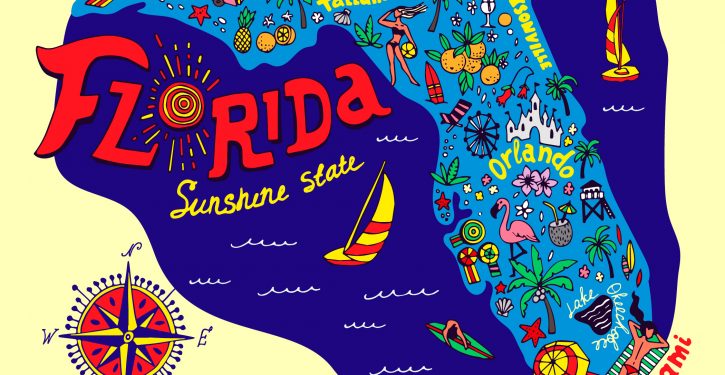
“Florida, Florida, Florida,” said the late Tim Russert of NBC’s “Meet the Press” fame, predicting that a victory in the state was key to winning the 2000 presidential election.
Russert’s now iconic phrase then progressed from accurate prediction to the backdrop for a combative recount after 537 Florida votes separated Republican nominee Gov. George W. Bush from his Democratic opponent Vice President Al Gore.
Then, it took 35 post-election days for the drama to finally end when a controversial 5-4 Supreme Court decision awarded Florida’s 25 electoral votes to Bush — effectively crowning him the next president of the United States.
Will this presidential election be the most important in American history?
Eighteen years later it’s still “Florida, Florida, Florida,” but with even more gusto.
The state now boasts 29 “purple” electoral votes while surpassing New York in 2014 as the nation’s third most populous state. Florida is also considered the “mother of all battleground states” voting for the winner of the last six presidential elections. And, starting with the 1980 election, nine out of the last 10 presidents won Florida. (Bill Clinton’s 1992 victory was the only exception.)
Given the state’s presidential importance, and with the midterm elections only five months out, Florida’s news events, mixed with demographic trends, have created a confluence of elements fit for a national political test tube. Therefore, for the first midterm election in the Age of Trump, the president’s part-time home state is the one to watch on November 6 with the results being a bellwether for the 2020 presidential election.
First trend – Hispanic and new Puerto Rican voters
Will Florida’s Hispanic voter turnout substantially increase among this growing demographic that traditionally votes overwhelmingly Democratic? More specifically, the wildcard question of 2018 concerns the influx of Puerto Ricans who fled to Florida after Hurricane Maria devastated their island. How many of these new residents will register and vote — 5,000, 50,000 or even 100,000?
That question makes Republican leaders extremely nervous, and for good reason.
In 2016 Hispanics comprised 18 percent of Florida’s voters, up from 17 percent in 2012. Hillary Clinton won Florida’s Hispanic vote by 62 to 35 percent. Trump won the state by 1.2 percentage points — only 112,911 votes out of 9.1 million votes cast.
Furthermore, in the last 2014 midterm election, Republican Gov. Rick Scott won reelection by only one percentage point over Democrat Charlie Crist (formerly Florida’s Republican governor). Scott, earning 64,145 more votes out of 5,666,541 cast speaks volumes about the impact new Puerto Rican voters could have on “normal” razor-thin margins of victory in what is a highly contentious U.S. Senate race as incumbent Sen. Bill Nelson runs for his fourth term against Gov. Rick Scott. Add to that a combative race for governor along with 27 House seats on November’s ballot.
Unfortunately for Republicans, over a decade before Hurricane Maria and due to Puerto Rico’s chronic economic crisis, Florida’s Puerto Rican population has been growing. Meanwhile, national Democratic money is pouring in as Democrats salivate over potentially tens of thousands of new Puerto Rican loyalists angry at President Trump for not doing more to rebuild their island. And, the exasperation just increased after a new study found 4,645 hurricane-related deaths not previously reported.
Will Florida’s Hispanic voters flex their growing muscles in November and help defeat Republican candidates? That answer will be dissected within the political “test tube.”
Second trend – Energized Youth Vote
Will the much publicized “youth vote” actually be energized and mobilized to turn out in Florida’s midterm election? Will they rally around the issue of gun control that heavily favors Democrats?
Politico’s Marc Caputo summarized the political sentiment in his daily Florida Playbook newsletter after four children were shot dead in Orlando on Monday with a police officer in critical condition, writing:
“Florida has long been awash in guns and madmen and the twain too often meet. Before Pulse (49 dead, 53 wounded) and then Parkland (17 dead, 17 wounded), yesterday’s murders would have been just another Florida crime story. But this is the post-Parkland Era. The political center on guns has shifted. It’s an election year. All major Democratic candidates for governor and U.S. Senate are calling for gun control. All Republicans aren’t. And it’s the second anniversary of Pulse. Shootings are part of the political discussion.”
Keep in mind, Florida’s nickname is the “Gunshine State” since gun ownership is excessive and gun shows are popular weekend activities. Those facts conflict with this new anti-gun/anti-NRA furor to register high-schoolers turning age 18 in November — a consequence of three mass shootings in Florida since 2016. (Caputo only mentioned two mass shootings, but five travelers were also shot dead at Ft. Lauderdale/ Hollywood International Airport on Jan. 6, 2017)
With anti-gun sentiment virtually on the ballot, will the youth movement, led by Parkland high school activists and their families, translate into large numbers of new voters and affect close races in Florida? Check the test tube after November 6.
Finally, there is no doubt that the potential exists for young and Hispanic/Puerto Rican voters to tilt the midterm election results toward Florida Democrats in November. However, I sighed when the sponsor of the aforementioned Florida Politico Playbook displayed the following message:
“Presented by AARP: There’s only one true deciding factor in this year’s elections: 50-plus voters. They won’t be ignored and their votes are up for grabs. Medicare, Social Security, support for family caregivers, and prescription drug costs are all on the line—so you can be sure they’ll be voting in record numbers.”
Yes, this group tends to tilt Republican and is also growing exponentially in Florida. But whether the over 50-plus vote will again be the “only one true deciding factor” remains to be seen. But, what is certain is that all political eyes will be on “Florida, Florida, Florida” in the November midterms, as a national test tube for emerging 2020 trends with repercussions for the presidential election.
Cross-posted at Townhall.




